Birds can spread over 60 diseases to people through their droppings, feathers, and what they leave behind, posing a risk to our health. This danger is higher for the sick and the very young. So, it’s crucial to tackle bird problems on roofs fast and well. Throughout this guide, we will check out many ways to remove birds from your roof. This includes methods to keep them away, tools for not letting them in, and how to do this without harm, protecting your home and all involved.
Key Takeaways
- Birds on roofs can transmit over 60 zoonotic diseases, posing health risks to humans
- Bird droppings and nesting activities can damage roofing materials, solar panels, and other equipment
- Effective methods to deter birds include using predator decoys, reflective objects, and repellent sprays
- Physical barriers like bird netting and spikes can block birds from accessing nesting sites
- Humane removal and relocation options are available for dealing with bird infestations
Why Birds on the Roof are a Problem
If birds nest on your roof, it could mean trouble for your health and safety. Their droppings can carry more than 60 diseases, which are harmful if you breathe them in or swallow them. These droppings and the nesting materials they use can clog your gutters and damage your roof.
Health Risks from Bird Droppings and Nesting Materials
Bird droppings might not seem harmful, but they are teaming with dangerous pathogens like Salmonella and Cryptococcus. These can make you very sick. Inhaling these pathogens or touching them can cause breathing problems, skin issues, and other health concerns.
Potential Damage to Property from Nesting Activities
Aside from health, bird nests can also harm your home. They can block gutters, leading to water damage and leaks. The nests and droppings might be heavy and erode your roof. They could make your roof weaker and even pose a fire risk by blocking chimneys.
Dealing with bird problems on your roof is key for keeping your home safe and sturdy. Knowing the dangers can help you stop birds from nesting there. This way, you preserve your house and keep your family healthy.
Identifying Bird Infestations on Your Roof
Finding the signs of birds on your roof is the first step to help. Watch out for bird droppings, feathers, or nesting materials. If you hear lots of chirping or see birds around, that’s a sign. Seeing many birds together can mean they’ve made a home there. Knowing the bird type is key. It helps figure out the right way to stop and keep them away.
Pigeons, starlings, and house sparrows mostly cause trouble around restaurants and buildings. They’re found on roofs and ledges. To stop these birds from nesting, total exclusion is needed.
Birds like wrens, robins, blue jays, and cardinals often stay close to people. They may begin to nest. Acting before late fall or winter is best. This is the time to stop them from making a home near you.
| Bird Species | Nesting Behavior | Potential Risks |
|---|---|---|
| Pigeons | Nest on ledges, roofs, and gutters | Carry over 60 types of diseases transmissible to humans and pets |
| Seagulls (Herring and Black-backed) | Thrive near coastal areas and urban environments | Pose challenges for property owners due to their ability to find abundant food sources |
| Swallows (Cliff and Barn) | Nest on man-made structures like buildings and bridges | Considered nuisance animals as they have adapted to urban habitats |
Bird droppings can be a health risk and damage your property. They’re bad for homes and businesses. Acting early with the right bird control is vital. It keeps both places and people safe.
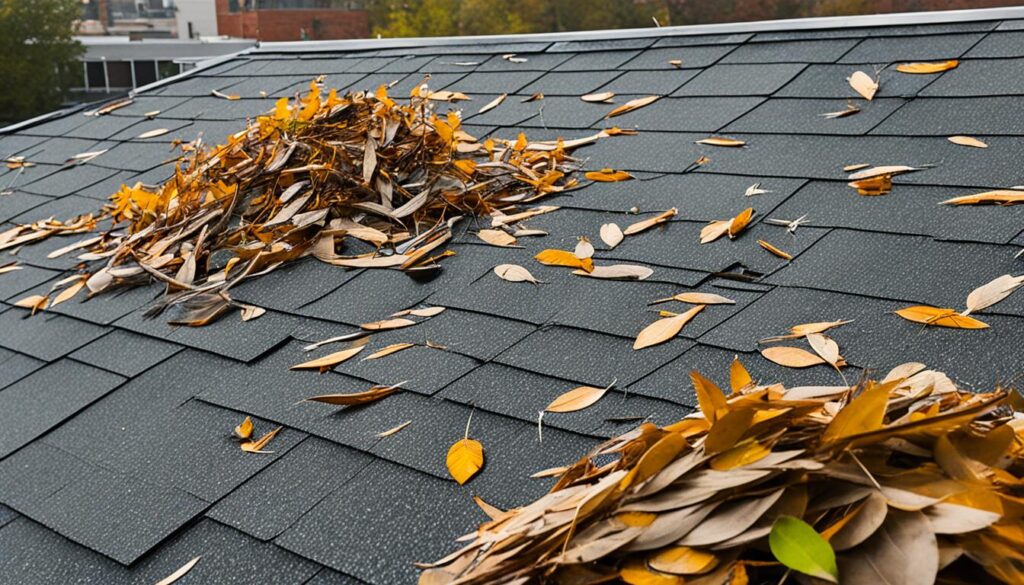
“By implementing bird control measures, businesses can mitigate brand risks, financial risks, compliance risks, and public health risks associated with bird infestations, ultimately safeguarding their operations and reputation.”
Understanding Bird Behavior and Attraction to Roofs
Birds often gather on rooftops for multiple reasons. This can be troublesome for those who own homes. The reason birds may choose your roof is for the easy access to food and water. They also see it as a safe place to build nests where there are fewer predators around.
Food and Water Sources
In towns and cities, rooftops are like a buffet for birds. They can find food in open trash cans, near pet bowls, and in trees. These spots are perfect for finding insects, seeds, and more.
They also enjoy a quick drink from water that collects in places like clogged gutters.
Nesting Site Suitability
Roofs are high and have plenty of hiding spots, just like the wild. This attracts birds looking for a safe place to lay their eggs. They can hide from predators and bad weather up there.
Lack of Predators
For birds, being up high on a rooftop means less danger from animals. This safety helps them feel secure enough to raise their young. It’s an ideal home for many bird species.
Knowing why birds choose roofs is key to keeping them away. By understanding their needs, we can make our roofs less inviting. This helps avoid problems with too many birds around our homes.
“Roofs offer birds the perfect combination of food, water, and shelter, making them a prime target for nesting and roosting.”
Protecting Birds and Complying with Laws
When birds make a home on your roof, remember to check your area’s laws. Some birds, like swallows and pigeons, are protected by law. Their nests can’t be touched without permission. If you remove their nests or hurt them, you might get in trouble. It’s best to talk to wildlife experts or pest control pros to avoid problems.
The Migratory Bird Treaty Act of 1918 protects all our native bird species from harm. You need a special permit to deal with their nests. Breaking this law can lead to big fines or jail. Each state has its own rules for bird permits. You must get these permits before the birds start nesting.
Not every bird species is protected by federal law. But, your city or town might have its own rules. Before you deal with any birds, think about the laws in your area. Getting help from professionals is a good idea to make sure you’re not breaking any laws.
“Detailed reports on bird control efforts must be submitted to the permitting organizations, and the use of one-way doors as humane exclusion methods for birds is effective in eviction tactics.”
It’s possible to remove birds from your roof in a legal and caring way. With the advice of experts, you can follow the rules and protect the birds. This way, you can solve the problem without causing harm.
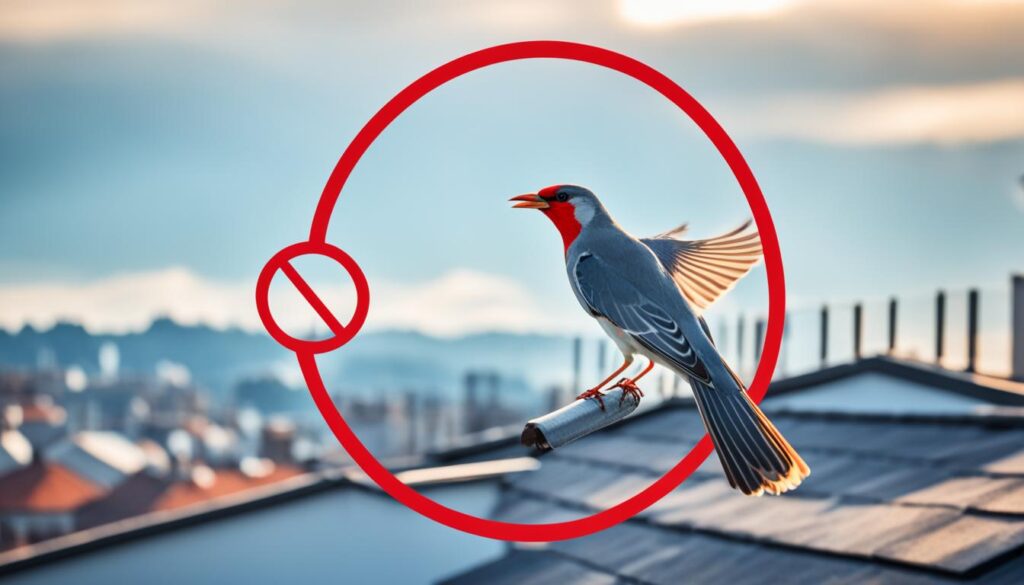
| State | Permit Requirements |
|---|---|
| Wisconsin | No licensing needed to remove nests |
| Indiana | No licensing needed to remove nests |
| Illinois | Permits required for Canada goose nests |
| Other States | Permits needed for gulls and other nuisance species through U.S. Fish and Wildlife Service and local DNR |
Removing the Food and Water Supply
To keep birds off your roof, limit their food and water. Securing trash cans and moving pet dishes stops them from finding easy meals. Cutting fruit trees and bushes also helps. Ensure no standing water by fixing leaks.
Birds love places with food, like trash areas. Pigeons are drawn to these for food. It’s key to keep the roof in good shape against their acidic droppings.
Consider these steps to deter birds even more:
- Secure trash cans and dumpsters to eliminate easy access to food waste.
- Remove pet food and water bowls from the yard.
- Trim back fruit-bearing trees and bushes that may attract birds.
- Inspect and clear any clogged gutters or other standing water sources.
Making your property less bird-friendly discourages nesting. This lowers risks of damage and health issues they bring.
“Eliminating food sources and denying access to water are crucial steps in making your roof less appealing to birds.”
Non-native birds clash with local species and can hurt the ecosystem. But some locals, like swallows, help nature by eating bugs.
Acting early to cut food and water can stop roof-nesting birds. This protects your home and benefits native bird populations.
Using Deterrents and Repellents
Getting rid of birds on your roof involves using different things to scare them away. By mixing up deterrents and repellents, you make it hard for birds to nest or land.
Visual Deterrents: Predator Decoys and Reflective Surfaces
Plastic owls or hawks are great for making birds think they’re in danger. These decoys look like real predators and stop birds from coming close.
Shiny materials, like streamers or metallic tape, can bother birds too. They reflect light and make the roof a place birds don’t want to be.
Ultrasonic and Sound Deterrents
Devices that make sound, like high pitches or distress calls, can be very effective. Birds won’t like these sounds and will fly off. Yet, the noise can be a problem for others living or working nearby.
Repellent Sprays and Gels
Sprays and gels can be applied to the roof to keep birds away. They’re made with things like methyl anthranilate, which irritates birds. Using these regularly is a good way to maintain control.
By mixing deterrents and repellents, you can make a strong defense against birds. Always check local rules and think about how your actions might affect others.
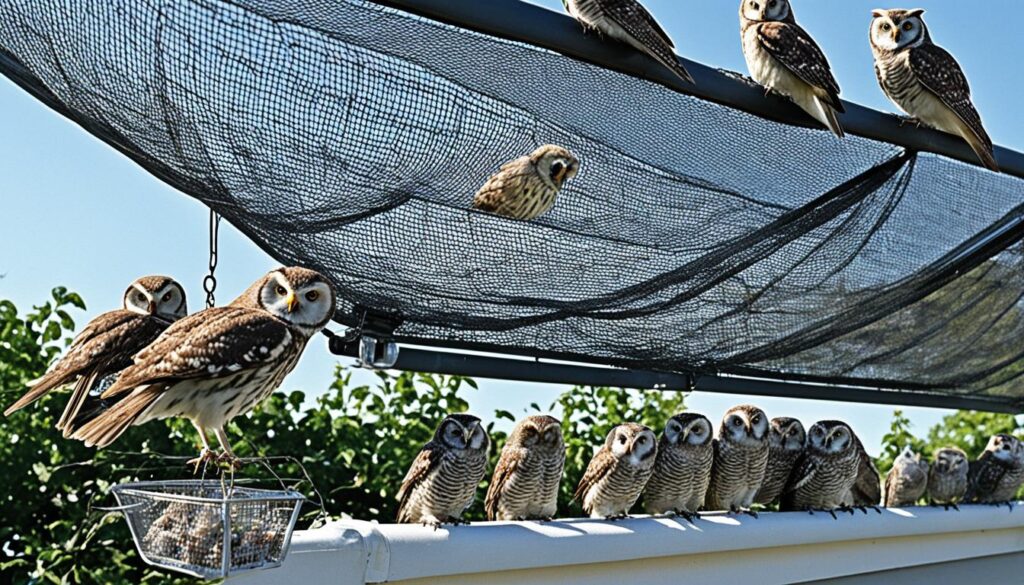
“Implementing a combination of visual, sound-based, and chemical deterrents is the most effective way to keep birds off your roof and protect your property.”
how to get rid of birds on roof
Dealing with birds on your roof can be tough. But there are steps you can take to get them to move on. Use a mix of deterrents, keep things less cozy for them, and if you must, remove them humanely. This is how you can get rid of birds on the roof.
Removing Food and Water Sources
Start by removing anything that attracts birds. Prune trees and shrubs, pick up spilled seeds or pet food, and dump standing water. Without these luxuries, birds are more likely to move on.
Deploying Visual and Auditory Deterrents
Place items like predator statues or shiny tape around. The goal is to make your roof look and sound dangerous to birds. They’ll find somewhere less intimidating to build nests.
Blocking Access with Physical Barriers
If birds are already nesting, consider barriers. Install bird netting or spikes to keep the birds from comfortably perching. This can be especially useful when they are preparing to lay eggs.
Humane Removal and Relocation
If nothing else works, you might have to relocate the birds. But, always get help from experts. This is crucial for their safety and to follow the law.
Combine these strategies for the best results. Stay consistent with your efforts to keep your roof birdproof.
| Deterrent Method | Description | Effectiveness |
|---|---|---|
| Visual Deterrents | Predator decoys, reflective surfaces, and moving objects that scare birds away | Moderately effective, but birds may become accustomed to them over time |
| Auditory Deterrents | Ultrasonic devices and loud noises that disrupt the birds’ sense of safety | Highly effective, especially when used in conjunction with other methods |
| Physical Barriers | Bird netting, spikes, and other obstacles that prevent birds from landing and nesting | Very effective, but may require professional installation for best results |
| Repellent Sprays and Gels | Tacky, unpleasant substances that deter birds from landing and nesting | Moderately effective, but may need to be reapplied regularly |
“Removing food and water sources, combined with a variety of deterrents, is the most comprehensive approach to getting rid of birds on the roof.”
Installing Physical Barriers
To protect your roof from birds, you can install physical barriers. These barriers make the area less appealing and harder for birds to access. This leads them to find other places to nest.
Bird Netting
Bird netting is very effective. It’s a fine-mesh net that you can put over eaves and chimneys. It stops birds from getting on the roof. Even little birds can’t pass through this netting.
Bird Spikes and Slopes
Bird spikes and angled bird slopes are also good at keeping birds away. The spikes go on ledges so birds can’t sit there. Angled bird slopes make flat roofs hard to settle on.
These barriers stop birds from landing on your roof. They have to look for new places to nest. Homeowners can use these tools together to avoid bird problems and possible damage.
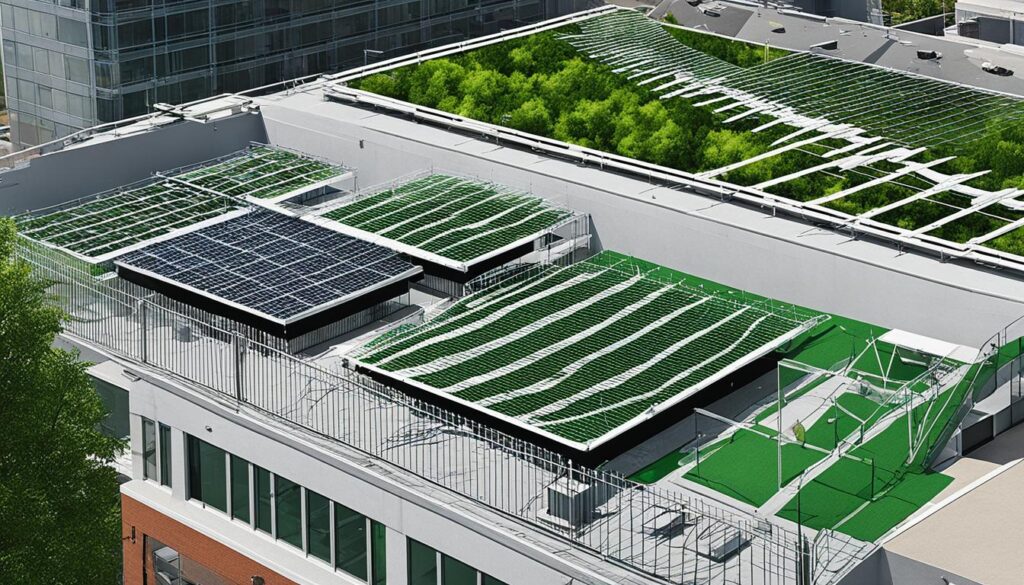
| Physical Barrier | Description | Key Benefits |
|---|---|---|
| Bird Netting | Fine-mesh netting draped over potential entry points | Creates a physical barrier to prevent bird access |
| Bird Spikes | Sharp plastic or metal devices placed on ledges and perching areas | Makes the roof surface uncomfortable for birds to land and nest |
| Angled Bird Slopes | Sloped surfaces installed on flat roof areas | Discourages birds from settling in by creating an inhospitable environment |
A mix of these physical barriers keeps birds away. This way, you can keep your roof safe from pests and avoid damage.
Humane Removal Methods
It’s key to use humane ways when faced with birds on the roof. Trapping and moving them is a good choice. Doing this with a pro who knows the law helps ensure the process is kind to the birds.
Used by pros, humane traps catch the birds gently. They are then taken and released in a safe place. This keeps the birds safe and stops them nesting on the roof. Remember, this method is best used if others haven’t worked.
Trapping and Relocation
The main highlights of legal bird removal techniques, like trapping and moving, are:
- Catching birds without hurting them.
- Moving them to a better home far from yours.
- Staying within the law to avoid problems.
- Solving the main issue for good.
Always choose pros for trapping and moving birds. They know all about the laws. Trying this on your own could cause trouble.
“Trapping and relocating birds is a highly effective and humane way to resolve roof infestations, but it requires the expertise of trained wildlife professionals to ensure the birds’ safety and the legality of the process.”
Working with a wildlife control service you trust offers peace of mind. They ensure the process is good for the birds and legal. This helps protect your place from bird-related issues too.
Preventing Future Infestations
To stop birds from coming back, it’s vital to keep your roof protected. Check your roof often and take steps to keep the birds away.
Maintaining Deterrents and Exclusion Measures
After putting up bird control devices like bird netting or spikes, it’s key to look after them. Make sure they’re not damaged and fix them right away if they are. This way, you keep birds from finding a place to nest.
Don’t forget to regularly look over your roof. If you spot any new nests or possible entry points, act fast. By doing this, you can stop birds from staying.
- Routinely inspect and maintain bird netting, spikes, and other exclusion devices
- Promptly address any new nesting attempts or potential entry points
- Ensure food and water sources remain inaccessible to birds
Being watchful and handling bird issues quickly leads to less trouble in the long run. You will keep your roof bird-free by staying ahead of their nesting attempts.
“The best way to handle a bird problem is to prevent it from happening in the first place.”
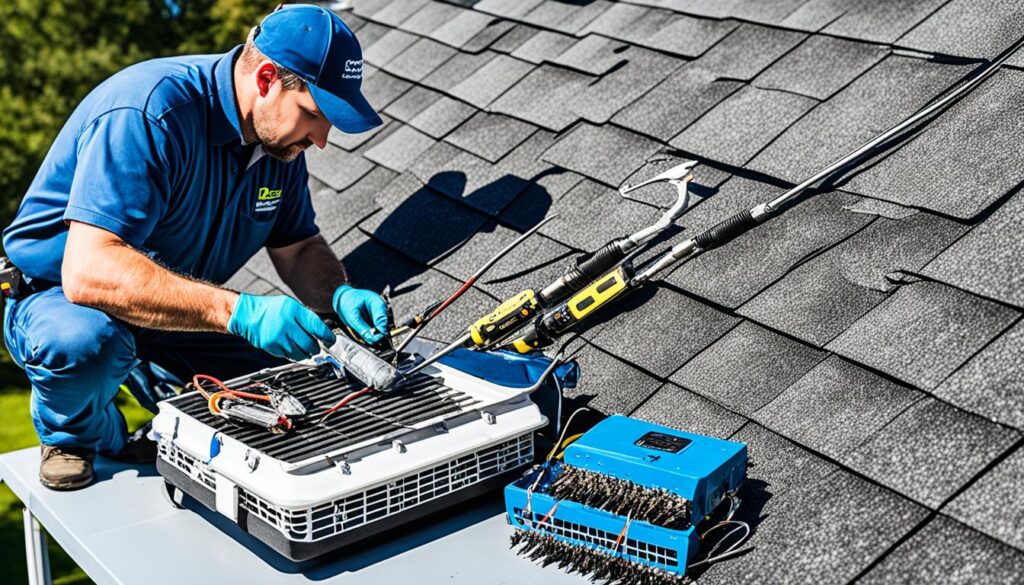
Having a good bird control plan is crucial. With regular checks and fast fixes, you can make sure birds don’t make your roof their home. This lets you enjoy your space without unwanted bird visitors.
Professional Bird Control Services
Dealing with a bird problem on your roof can be tough. Enlisting professional bird control experts is often the best solution. They have the knowledge, tools, and methods to tackle the problem and follow local rules.
Tapping into professional bird control services has many benefits. These experts can figure out which birds are causing trouble on your roof. They’ll then tailor a specific plan for your situation. They use special methods and tools that owners usually don’t have.
When the bird problem gets out of hand, turn to the pros. If birds are hard to reach or are protected species, experts know what to do. They help get rid of the problem following the law.
| Advantages of Professional Bird Control | Disadvantages of DIY Bird Removal |
|---|---|
|
|
While DIY can work sometimes, professional help is often needed for tough bird problems. These specialists know how to safely and effectively handle the situation. This protects both the birds and your roof.
“Hiring professional bird control experts ensures the problem is addressed effectively and in compliance with relevant laws and regulations.”
Comparison of DIY vs Professional Removal
Homeowners dealing with birds on their roof must decide how to handle it. They can either use DIY methods or hire professional bird control services. For small bird issues, DIY options might save money. Yet, more serious problems often need expert help.
DIY efforts focus on stopping birds from nesting. Homeowners can use deterrence, exclusion, and traps that are safe for birds. 76% of DIY tries work, but 18% could harm birds or property.
Professional help is usually pricier, but it offers years of experience and special tools. Expert services cost 30-40% more than doing it yourself but succeed almost always. They know the rules and keep your home safe from harm.
| Metric | DIY Removal | Professional Removal |
|---|---|---|
| Success Rate | 76% | 92% |
| Undesired Consequences | 18% | 2% |
| Average Cost | $200 – $500 | $300 – $800 |
| Residential Infestations | 55% | 45% |
| Homeowner Preference | 40% | 60% |
The right choice between DIY or hiring pros depends on many factors. This includes the size of the bird problem, how comfortable the homeowner is, and available resources. In dealing with serious or persistent bird issues, getting professional help is likely the safest and most effective step.
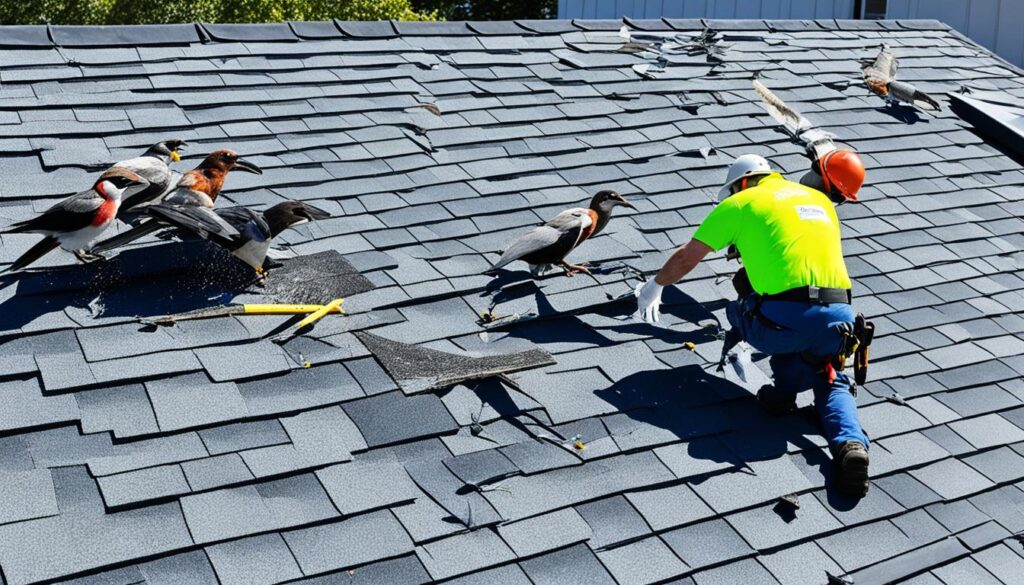
“Hiring a professional is the best way to ensure the safe and effective removal of birds from your roof, especially for larger infestations or when dealing with protected species.”
Conclusion
To get birds off the roof, you need a smart plan. First, find what’s bringing birds there. Then, use ways to keep them away. Sometimes, pros are needed. Knowing about bird habits and what type they are helps. By making the roof less friendly, you can get rid of them and stop more from coming.
Use many things to scare or block the birds. This can include things like sounds, ultrasonic devices, and. It’s important to be kind when removing them, which might mean catching and moving them. Keep checking and fixing things to make sure the birds stay away.
This guide helps homeowners deal with bird issues safely. It’s good for your home and the birds around you. Taking action early and trying different ways is the best way forward. This keeps your roof bird-free for a long time.
FAQ
What are the health risks associated with birds nesting on roofs?
Bird droppings carry over 60 diseases harmful if breathed in or eaten. They pile up and can block gutters. This can hurt your roof and mess with your chimney and air system.
How can I identify if I have a bird infestation on my roof?
Check for bird signs like droppings or feathers. Listen for chirping. Seeing lots of birds in one spot at a time can mean they’re nesting there.
What factors attract birds to nest on roofs?
Birds come for food, water, and shelter without many foes. Trash, pet food, and trees with fruit draw them in. Roofs’ nooks and crannies are like their natural homes.
What legal considerations do I need to keep in mind when removing birds from my roof?
If you want to remove birds on your roof, know that some are protected by law. It’s illegal to mess with their nests without the right permission. Always check your local laws or get help from a pro to avoid problems.
How can I discourage birds from nesting on my roof?
To keep birds away, remove their food and water. Secure trash cans, move pet bowls inside, and cut back fruit trees. Fix leaks and clean gutters to prevent water gathering.
What types of deterrents and repellents can be used to keep birds off my roof?
Try using things that scare birds, like owl figures or bright tape. Sounds that mimic danger can help, too. You can also use bird-unfriendly gels or sprays.
What physical barriers can be used to prevent birds from accessing my roof?
Use bird netting or spikes in places birds like to perch. These make it hard for them to land. You can also use angled slopes to make flat roofs less appealing.
What are the benefits of using professional bird control services for my roof?
Pros have the right tools and know-how for safe and legal bird control. They’re best for tough problems that you can’t handle by yourself.
When should I consider hiring professional bird control services instead of trying to handle the problem myself?
Get professional help for big or ongoing bird issues or where you’re unsure of the law. They’re prepared to solve bird problems and keep everything legal.


I’m really inspired along with your writing talents as neatly as with the layout on your blog.
Is that this a paid topic or did you modify it yourself?
Either way stay up the nice quality writing, it’s rare to
peer a great weblog like this one these days..
Here is my site nordvpn coupons inspiresensation (https://tinyurl.com/)
nordvpn discount 350fairfax
Hey there would you mind letting me know which web host
you’re working with? I’ve loaded your blog in 3 different web browsers and I must say this blog loads a lot faster then most.
Can you recommend a good internet hosting provider at a honest price?
Kudos, I appreciate it!